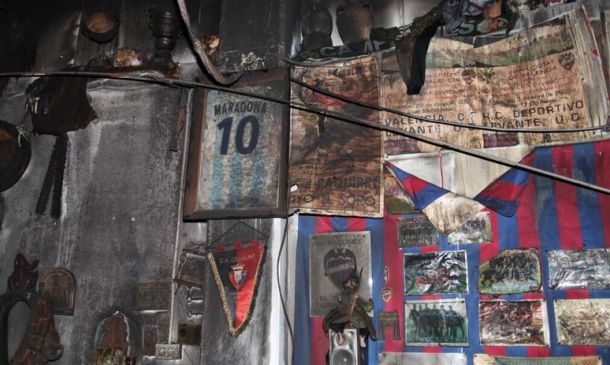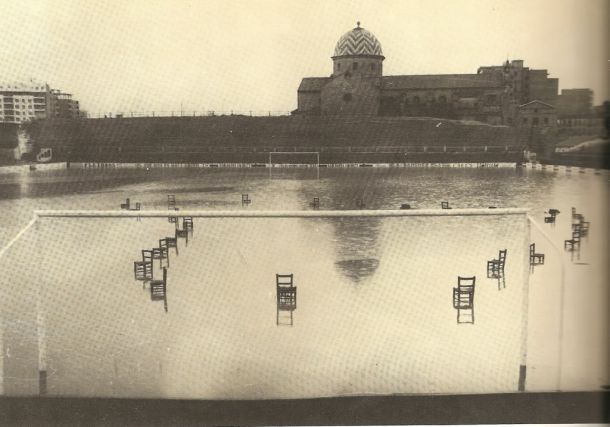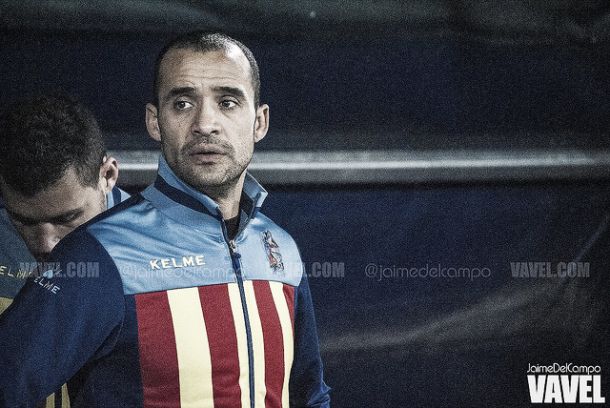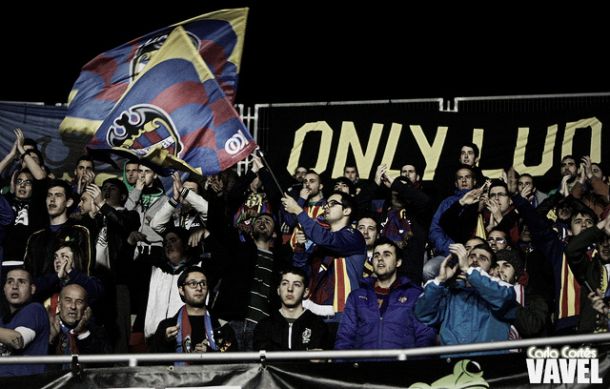A phone call in the middle of the night brought the police and a firefighter unit to the home of Levante UD. Smoke was coming out from the Ciutat de València the past 28th of May. No human was injured. Not physically at least, but pain could be seen in the eyes of Raimon, the groundskeeper. It was his small room, his “raconet”, the only one devastated by the flames. A hole life of football turned into dust. All kind of memorabilia, not only from the valencian club, disappeared: boots, shirts, pictures... This also was the place where the players and the employees had eaten paella before or after every major success. It was special and unique.
The fans wanted to rebuild the place. Even footballers like Andrés Palop, former Sevilla and Valencia (Levante's local rivals) goalkeeper offered his help by donating shirts of his own. Now the club is aiming to build an official new museum. It wasn't the first time that Levante was damaged and had to stand up again as a phoenix arises from its own ashes.

Born by the seaside, and receiving the name of the wind that enters Valencia from the Mediterranian, the history of the oldest club in the region hasn't been a walk in the park. The “granotas” (frogs in the local language) won their first and only trophy 30 years after its birth. It was the Costless Spain's Cup in 1937. One year of civil war couldn't stop the ball rolling on, and the main cup tournament was substituted by another two: one for those territories that fell into Francisco Franco's arms, and another one for those that still hadn't. Levante won three games, draw two and lost only one. A place in the final game was well-earned. There, they would face Valencia CF, a team they had beaten twice (0-4 and 5-2) in the group stage. Nieto put the ball in the back of the net with just 12 minutes remaining to give Levante their only major trophy... not recognized yet by the Spanish FA as Franco's regime nullified any sports achivement gained in republican soil.
A club with no home
The war left Spanish people with no costlessdom, no future, and left Levante FC with no stadium. Meanwhile another club (Gimnástico) from the center of the city had lost most of its players in the conflict. The solution for both headeaches was a merge. Levante UD was the resulting team, wearing Gimnástico's colours (red and blue) and keeping the name of the oldest of the two (and its black and white as an away kit since ever then).
The merge followed the steps of their ancestors who never played in the top flight. They couldn't settle down in any division, and became a yo-yo club within the lower tiers of Spanish national football. The frogs didn't had their first spell in First Division until 1963. After two seasons, Levante was relegated again and its fans had to wait another 40 years to get back to La Liga. Quite a long walk in the desert.

Tougher than tough
Alright, every club has its ups and downs. There are some fans that had never seen their team battling in the top tier, and they probably never will. What could be worse than not being with the giants of football? Simply not being. Not anymore.
After having a small taste of La Liga, Levante chairman, Pedro Villarroel, wanted more and drove the club to bankruptcy in his continuous attempts of settling the club in the first division. The oldest club in Valencia was in real danger. No more fights over a ball in the grass, what mattered then was what happened in the offices. A dramatic relegation to the second tier in the 2007/08 season and a debt of 80M euros, lead to the departure of most of the players. In the summer of 2008, Levante UD only had eight footballers in its squad.
Levante, at the time, was already used to face huge difficulties. This one, however, was tougher than tough. Without the possibility of spending a single euro on transfers, Levante build a new squad based in players of the academy, club's have-beens like Juanfran or Ballesteros, and footballers nobody wanted for their teams.
They say that when times are harder, everyone gets closer and works side by side instinctively. A bunch of hard-workers were ready to bring blaugrana's die-hard fans to Europe out of nowhere.

The path to dreamland
Levante were promoted against all odds with a squad designed to avoid relegation in 2009/10. The perfect gift. The celebration of the 100th anniversary started as dark as the worst nightmare and ended up with the brightness of fairytales. The dream had just begun. Wins in the local derby, wins against Real Madrid or league champions Atlético de Madrid, five consecutive seasons in the top tier (previously they just managed to stay two years up)... Levante even reached the quarter finals of the Europa League, losing in extra-time against Rubin Kazan in Moscow. The unthinkable turned to be real.
Influence in the local football fans has grown massively. From the regulars two or three thousand when in second tier, to more than 16.000 season ticket holders nowadays. It seems that all hurdles in the world can't stop this small club from getting bigger and bigger. Each season they sell their most valuable player and sign new ones. Keylor Navas will be the last number in joining a list that includes Felipe Caicedo, Arouna Koné and Obafemi Martins. New opportunities for both the club and the yet unknown player. The debt is decreasing faster than imagined. Once it's over, Levante fans have a bright future in front of them. The frogs that arised from the ashes to turn into a prince, as in fairytales -with no kisses within the storyline-, will be stronger than ever.











































